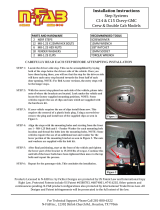
Freescale Semiconductor, Inc.
User’s Guide
© 2015 Freescale Semiconductor, Inc. All rights reserved.
1 About this document
This user’s guide describes the hardware for the Freescale
USB-KW019032 development platform.
The USB-KW019032 board is the core evaluation and
application development platform for the MKW01Z128
device, and can be used as a standalone evaluation solution
or used to develop software and applications.
The MKW01Z128 transceiver is a highly-integrated,
cost-effective, system-in-package (SiP), sub-GHz wireless
node solution with an FSK, GFSK, MSK, or OOK
modulation-capable transceiver, and a low-power ARM
®
Cortex
®
-M0+ CPU. The highly integrated RF transceiver
operates over a wide frequency range including 315 MHz,
433 MHz, 470 MHz, 868 MHz, 915 MHz, 928 MHz, and
955 MHz in the license-free Industrial, Scientific, and
Medical (ISM) frequency bands.
1.1 Audience
This guide is intended for system designers.
Document Number: USBKW019032UG
Rev. 0, 10/2015
Contents
1. About this document . . . . . . . . . . . . . . . . . . . . . . . . . 1
1.1.Audience . . . . . . . . . . . . . . . . . . . . . . . . . . . . . . . . 1
2. Safety information . . . . . . . . . . . . . . . . . . . . . . . . . . . 2
2.1.FCC guidelines . . . . . . . . . . . . . . . . . . . . . . . . . . . 2
2.2.Regulatory approval for Canada (IC RSS 210) . . . 3
2.3.Electrostatic discharge considerations . . . . . . . . . . 3
2.4.Disposal instructions . . . . . . . . . . . . . . . . . . . . . . . 3
3. USB-KW019032 overview and description . . . . . . . . 4
3.1.Introduction . . . . . . . . . . . . . . . . . . . . . . . . . . . . . . 4
3.2.Board features . . . . . . . . . . . . . . . . . . . . . . . . . . . . 4
3.3.Software and driver considerations . . . . . . . . . . . . 6
4. USB-KW019032 development board . . . . . . . . . . . . 7
4.1.USB-KW019032 board overview . . . . . . . . . . . . . 7
4.2.Functional description . . . . . . . . . . . . . . . . . . . . . . 9
4.3.Schematic, board layout, and bill of materials . . 15
5. PCB manufacturing specifications . . . . . . . . . . . . . . 23
5.1.Single PCB construction . . . . . . . . . . . . . . . . . . . 24
5.2.Panelization . . . . . . . . . . . . . . . . . . . . . . . . . . . . . 25
5.3.Materials . . . . . . . . . . . . . . . . . . . . . . . . . . . . . . . 25
5.4.Solder mask . . . . . . . . . . . . . . . . . . . . . . . . . . . . . 25
5.5.Silk screen . . . . . . . . . . . . . . . . . . . . . . . . . . . . . . 26
5.6.Electrical PCB testing . . . . . . . . . . . . . . . . . . . . . 26
5.7.Packaging . . . . . . . . . . . . . . . . . . . . . . . . . . . . . . 26
5.8.Hole specification / tool table . . . . . . . . . . . . . . . 26
5.9.File description . . . . . . . . . . . . . . . . . . . . . . . . . . 26
6. Revision history . . . . . . . . . . . . . . . . . . . . . . . . . . . . 26
USB-KW019032 Freescale USB
Dongle Development Board
User’s Guide




















